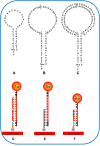Visual detection of single-base mismatches in DNA using hairpin oligonucleotide with double-target DNA binding sequences and gold nanoparticles
- PMID: 22386491
- PMCID: PMC4110906
- DOI: 10.1016/j.bios.2011.12.055
Visual detection of single-base mismatches in DNA using hairpin oligonucleotide with double-target DNA binding sequences and gold nanoparticles
Abstract
We describe a hairpin oligonucleotide (HO) with double-target DNA binding sequences in the loop and 11-base in the stem for visual detection of single-base mismatches (SBM) in DNA with highly specificity. The thiol-modified HO was immobilized on gold nanoparticle (Au-NP) surface through a self-assembling process. The strategy of detecting SBM depends on the unique molecular recognition properties of HO to the perfect-matched DNA and SBM to generate different quantities of duplex DNA on the Au-NP surface, which are captured on the test zone of lateral flow test strip via the DNA hybridization reaction between the duplex DNA and preimmobilized DNA probe. Accumulation of Au-NPs produces the characteristic red bands, enabling visual detection of SBM. It was found that the ability of HO to differentiate perfect-matched DNA and SBM was increased dramatically by incorporating double-target DNA binding sequences in the loop of HO. The signal ratio between perfect-matched DNA and SBM was up to 28, which is much higher than that of conventional HO or molecular beacon. The approach was applied to detect the mutation sites, Arg142Cys and Gly529Ile, of transglutaminase 1 gene in autosomal recessive congenital ichthyosis. The results presented here show that the new HO is a potential molecular recognition probe for the future development of nucleic acid-based biosensors and bioassays. The approach can be used for point-of-care diagnosis of genetic diseases and detecting infectious agents or warning against bio-warfare agents.
Copyright © 2012 Elsevier B.V. All rights reserved.
Figures




References
Publication types
MeSH terms
Substances
Grants and funding
LinkOut - more resources
Full Text Sources
Other Literature Sources
Miscellaneous

